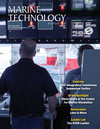
Page 18: of Marine Technology Magazine (July 2024)
Read this page in Pdf, Flash or Html5 edition of July 2024 Marine Technology Magazine
MARINE SURVEY
All images courtesy CMs GeoScience
PROJECT INSIGHTS:
THE CONVEX
SEASCAPE SURVEY
GeoScience partnered with the cores, as well as purify and sequence the DNA in Jersey. This
Blue Marine Foundation, the data was then taken back to Exeter where they will investigate
University of Exeter and Jersey which ? ora and fauna are contributing to carbon stocks and
CMs Marine Resources on The Con- determine how they have formed over the past two centuries. vex Seascape Survey project. This initiative is a collaboration As the survey team were able to conduct on-site analysis, the of scientists working to quantify and understand blue carbon data they generated can be validated once the other cores have stored in the coastal ocean ? oor, and the effects of marine life been received in Exeter, to better understand the impacts of upon it. Its aim is to deliver new, reliable open-source data storage and/or transportation.
designed to educate, inspire and enable informed decisions on The project also looked at how protection from trawling and ocean use, to harness the power of the sea in the ? ght against dredging activities might affect the capacity of the seabed to climate change. The role of CMS’s specialized geotechnical accumulate and store organic carbon. Researchers had a par- team was to collect 55 vibrocores and eight multicores across ticular interest in how this protection affects the biodiversity various locations in the waters around Jersey. of seabed habitats, as it is likely that the animals that live
They collected undisturbed samples of sediment and super- around jersey may play an important role in the ? ux of carbon natant water using a multi corer at eight locations on the south through these environments.
and east of the island. One core from each location was trans- The CMS team collected cores both inside and outside of the ferred back to shore where the research team could perform Jersey Marine Protected Area where mobile ? shing gear is pro- eDNA testing. hibited. This will allow academics to compare the differences
Dr Richard Tennant established a ? eld molecular labora- in seabed organic carbon content and biodiversity according to tory that allowed the team to both extrude and subsample the different levels of seabed disturbance. The samples they cored 18 July/August 2024
MTR #5 (18-33).indd 18 7/23/2024 1:49:46 PM

 17
17

 19
19
